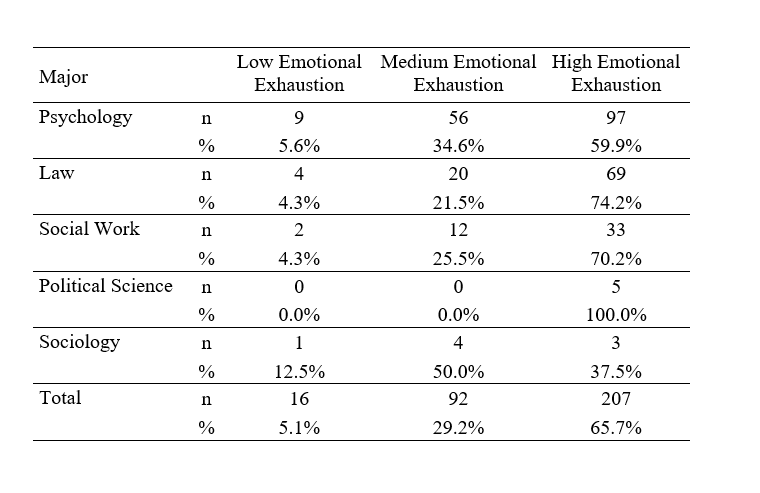Emotional Exhaustion and Mental Health in a Sample of Chilean Social Science Students During the COVID-19 Pandemic
PSOCIAL, vol. 7, no. 2, 2021
Universidad de Buenos Aires
Received: 18 September 2021
Accepted: 09 December 2021
Abstract: Emotional exhaustion and mental health in university students are a public health problem given the harmful repercussions they have on their quality of life and the possible future consequences, even more so if in the academic period the students are affected by a pandemic like COVID -19. This research aimed to determine the presence and degree of emotional exhaustion and its possible repercussions on mental health in social science students during the COVID-19 pandemic. The design was descriptive and cross-sectional, and a questionnaire was used with sociodemographic variables, perception of the affectation of mental health, and the scale of emotional exhaustion (ECE). The results were that a high percentage of 90.2% reported a worsening of their mental health with the presentation of stress symptoms (64.1%), sensitivity (41%), anxiety/distress (39.7%), irritability (39.4%), and depressive symptoms (34.9%). The influencing factors were the pandemic (61.9%), confinement and social distancing (47.3%), economic problems (41.6%), and the news (23.8%). In addition, a high (65.7%); medium (29.2%) and low (5.1%) emotional exhaustion. We can conclude that social sciences students find themselves with high degrees of emotional exhaustion and a perception of a great deterioration in their mental health. These results should call our attention to continue studying the mental health consequences of COVID-19 to prevent possible mental pathologies in the future.
Keywords: emotional exhaustion, mental health, university students, pandemic.
INTRODUCTION
COVID-19 is a disease that has wreaked havoc in all walks of life because of its high mortality and the political, social, psychological, educational, and economic consequences (Martínez, 2020). The loss of life will result in a more severe mental health crisis in patients, their families, communities, and health care workers (Omary, 2020). The COVID-19 pandemic has many elements that make it exceptionally stressful for students (Besser et al., 2020). Numerous factors may account for the increased risk to students in higher education, the mental health problems the pandemic may bring, the loss of important commencement and completion rites (Gruber et al., 2020). Studies conducted explicitly on college students in China reflect the high possibility of experiencing, witnessing, or facing various stressful events related to the occurrence of COVID-19, which resulted in negative psychological symptoms, such as feeling tense, fear of infection, insomnia, and low mood (Yang et al., 2020). Students who experience increased social isolation due to COVID-19 may have a higher risk of increased psychological distress (Hamza et al., 2020).
In non-pandemic time students face experiences that can be physically, emotionally, and psychologically challenging (Cushman & West, 2006). Despite the widespread prevalence of psychological distress affecting many students in higher education, the research on student stress remains largely theoretical (Williams et al., 2018). Students often experience high levels of stress and burnout (Humphrey, 2013). Stress often leads to burnout, which can seriously jeopardize a student's college experience (Schaufeli et al., 2020).
Burnout plays a fundamental role in students' lives (Cushman & West, 2006). In numerous works, the three dimensions of burnout syndrome have been studied: emotional exhaustion, depersonalization, and lack of personal fulfillment (Ramos et al., 2005).
Emotional exhaustion is a significant problem among higher education students and a public health problem in general (Tlili et al., 2020). Emotional exhaustion or burnout alludes to the situation in which people feel that they can no longer give more of themselves on an affective level; it is a situation of depletion of one's energy or emotional resources (Marrau, 2004). The problem of emotional exhaustion among adolescent and college students has recently gained broader prominence in national education policy in many countries (Galbraith & Merrill, 2015). More than one-third of college students experience detrimental imbalances between the effort they put into their studies and the rewards they get in return (Williams et al., 2018). The consequences of emotional exhaustion in students are as complex as other factors of mental distress, such as those related to smoking and alcohol consumption or an unhealthy lifestyle (Tlili et al., 2020). Contextual burnout can also extend to depression (Al-alawi et al., 2017) and anxiety (Farrell et al., 2019), internet dropout and addiction, and compromise with overall life satisfaction and success in educational pathways (Salmela-aro, 2017). In addition, there might be consequences such as dropout, sleep disorders, depression, and suicide (Pagnin et al., 2020) and even symptoms associated with posttraumatic and dissociative stress (Boudoukha et al., 2017). The use of drugs and alcohol to reduce stress is of concern (Erschens et al., 2018). A student's level of burnout directly impacts that student's level of efficiency and productivity (Galbraith & Merrill, 2015). It also increases their intention to withdraw from college (Williams et al., 2018). A student with high burnout may study the same amount of hours as a student with low burnout but may not be as productive due to the various emotional, behavioral, cognitive, and physiological reactions caused by burnout (Galbraith & Merrill, 2015).
Given the importance of emotional exhaustion and its possible repercussions on students' mental health and performance, it is necessary to determine the presence of this phenomenon and its potential consequences on the mental health of social science students in Chilean higher education during the COVID-19 pandemic.
MATERIALS Y METHODS
Study Design
It is a quantitative approach study. Its design was descriptive and cross-sectional.
Study Sample
The population consisted of 315 students in the area of social sciences in Chilean higher education. The selection criteria (inclusion and exclusion) were: university students, who are currently studying a social sciences degree in a higher education institution, over 18 years of age, and who freely agreed to participate in this research. The application of the instrument was carried out during November 2020, which was hosted on the GoogleForms platform.
Procedure
For the application of the instrument, a questionnaire with sociodemographic variables and one about the perception of their mental health and the Emotional Exhaustion Scale (ECE) was sent to the students e-mail addresses (Ramos et al., 2005). The participants were asked to give their informed consent in both questionnaires. It was made explicit that their answers were anonymous, voluntary and that the results would only be used for academic purposes. Once the data had been collected, we analyzed the results of this descriptive cross-sectional study (Hernández et al., 2015).
Data collection technique and instrument
The technique used was the survey, which is the most commonly used for data collection in descriptive and quantitative studies. For this study, a questionnaire was elaborated, which was validated through expert judgment, whose structure has the following characteristics: First, general information composed of general questions such as age, gender, career, in addition to questions regarding the perception of their mental health such as: "Do I think my mental health has worsened?", "At this time, I have presented symptoms of stress?" and "At this time, I have presented depressive symptoms?". In the end, the emotional exhaustion scale (ECE) was applied (Ramos et al., 2005). The Emotional Exhaustion Scale (ECE) is a specific scale that considers the last 12 months of student life; the MBI emotional exhaustion scale inspires these items (Maslach et al., 1997) as well as in Freudenberger's concept of burnout. To this base were added items specially designed to evaluate university students' exhaustion or emotional exhaustion, which derived from the level of demand and effort to overcome their studies (Ramos et al., 2005). The ECE is a unidimensional scale of 10 items. The items are scored from 1 to 5, depending on the occurrence of what the statement says: 1 = rarely, 2 = few times, 3 = sometimes, 4 = frequently, 5 = always. The score obtained on the ECE ranges from 10 to 50 points. Its level of internal consistency (an alpha coefficient of 0.893) and satisfactory item homogeneity (mean inter-item correlation = 0.33) for this application had a Cronbach's alpha of 0.877 (Table 1). For a more specific data analysis of the responses, degrees of emotional exhaustion were recorded as low from 10 to 23.33 points, medium from 23.34 to 36.66 points, and high from 36.67 to 50 points. SPSS version 25 was used for data analysis.

RESULTS
Table 2 shows the sociodemographic characteristics of the students of the various social science majors, which are distributed as follows:

Table 3 shows the perception of students in the social sciences concerning their mental health: 284 (90.2%) reported that their mental health has worsened, 202 (64.1%) reported stress symptoms, 124 (39.4%) irritability, 129 (41%) increased sensitivity, 125 (39.7%) anguish and/or anxiety, 110 (34.9%) depressive symptoms.

Table 4 shows that among the factors that most affected social science students were the pandemic (61.9%), confinement and social distancing (47.3%), economic problems (41.6%), and news and media about COVID-19 (23.8%).

Table 5 shows that the careers that belong to the area of social sciences present high levels of emotional exhaustion. Psychology high (59.9%), medium (34.6%) low (5.6%); Law high (74.2%), medium (21.5%) low (4.3%); Social Work high (70.2%), medium (25.5%) low (4.3%); Political Science high (100%); Sociology high (37.5%), medium (50%) low (12.5%).

DISCUSSION
This research shows the pandemic's complexity on the mental health of higher education students, generating a high level of emotional exhaustion. The perception of social science students is that more than 90% of them consider that their mental health has worsened in the period of the COVID-19 pandemic and that the main reason has been the COVID-19 pandemic with 61.9%. These findings are consistent with other findings that the general perception of higher education students is that their mental health has been impaired, even more so in students who had pre-existing mental illnesses before the pandemic (Banerjee, 2020; Hamza et al., 2020). This can lead to severe psychological decompensation (Y. Sun et al., 2020). It is increasingly evident that the pandemic confers serious and potentially complex long-term mental health consequences (Gruber et al., 2020).
More than 65% of the students presented high emotional exhaustion in our research. This refers to the situation in which people feel that they can no longer give more of themselves at an affective level; it is a situation of depletion of energy or emotional resources (Marrau, 2004) with consequences such as feelings of abandonment, sleep disorders, depression, and suicide (Pagnin et al., 2020). This emotional exhaustion may be due to the high demands of studies, cynical and distant attitudes towards their studies, and feelings of academic incompetence (Schaufeli et al., 2020). They have increased during the pandemic of COVID-19, given the changes from face-to-face to online study, which generates great wear to be in front of a screen without greater environmental stimulation. Therefore it is necessary to continue studying how the transition from face-to-face to online classes affects mental health since such a sudden transition could have harmful consequences for students (Besser et al., 2020; Gurung & Stone, 2020), especially for those in vulnerable situations. These interruptions can be especially traumatic (Lancaster & Arango, 2021). Therefore due to the global pandemic of COVID-19, students now face new and unprecedented challenges (e.g., significant academic changes and interruptions, stay-at-home orders, etc.) (Hamza et al., 2020).
Within our research, it can be observed that social science students perceive that 64.1% of them would present symptoms of stress. The above correlates with other analysis where perceived stress has increased, generating physical consequences and sleep disorders (Lancaster & Arango, 2021). These results are of concern given that a recent review strongly correlates stress with increased alcohol consumption (Acuff et al., 2021) and is associated with increases in anxiety and fear of getting sick (Danzi et al., 2021), as well as increases in emotional exhaustion (Chan et al., 2021). The degree of stress and adversity that people experience due to COVID-19 depends on economic, social, and health factors (Lancaster & Arango, 2021). As presented in our study, 41.6% of the students refer that financial problems have affected them, which could lead to relevant psychological issues given the insecurity that has brought the virus and the economic stability in general (Marler et al., 2021).
The perception of the presence of depressive symptoms and irritability reported by students in the social sciences was 34.9% and 41%, with greater sensitivity, which is in line with other studies in which they say that depressive symptoms are in the order of 20% to 30% in university students (Wang et al., 2020). The findings support the primary hypothesis that the prevalence of probable moderate to severe depression, self-harm, suicidal ideation, and emotional distress due to COVID-19 was significantly higher among quarantined participants than non-quarantined participants (Xin et al., 2020).
In our study, more than 39% of the students reported presenting anxiety and/or distress symptoms, which is consistent with other research where 20% to 35% of the respondents reported anxiety and over 25% reported high levels of stress after the onset of the outbreak (Cao et al., 2020; Huang & Zao, 2020). Furthermore, the findings corroborate the interaction between ongoing pandemic-related stress and fear of COVID-19 (Chan et al., 2021). This can be associated with our results: 61.9% of students refer the pandemic itself had affected their mental health the most and that 23.8% of students felt that the news had affected them. Along these same lines, 47.3% of students identified that confinement and social distancing had affected them. In particular, young adult college students may be a population vulnerable to psychological distress during quarantine (S. Sun et al., 2021). A recent meta-analysis of 25 empirical studies found that those in quarantine were more likely to be anxious (odds ratio, OR) (OR = 2.0) and depressed (OR = 2.8) (Henssler et al., 2021). This may lead to increased suicidal thoughts and ideation (Martínez-Líbano & Yeomans Cabrera, 2021; Pandey et al., 2020). However, other research has shown that wellbeing was not affected by concern about the consequences of the virus. Although respondents showed some fear of infection and severe illness in someone in their networks and had doubts about the efficiency of medical care, these factors did not negatively affect their wellbeing (Lukacs, 2021).
Addressing the consequences of emotional exhaustion is necessary to preserve good mental health, which can be defined as a state of wellbeing that enables people to cope with life's everyday stresses and function productively (Fusar-Poli et al., 2020). Findings have consistently demonstrated the importance of psychosocial factors and mental health in the academic success of college students (Kivlighan et al., 2020). Psychological problems, such as depression and anxiety, are common among students (Kim et al., 2015). College students have long-standing mental health conditions and suicide risks (McLaughlin & Gunnell, 2020).
It is essential that the authorities address this issue and urgently seek solutions to mitigate the psychological impact of home confinement (anxiety, stress, depression, frustration, among others) (Yeomans & Silva, 2020). Universities have a responsibility to advocate for students, especially for those students who are vulnerable (Benner et al., 2018). Fostering resilience is a promising way to mitigate the adverse effects of stressors, prevent burnout and help students thrive after difficult experiences (Houpy et al., 2017).
CONCLUSION
The COVID-19 pandemic has profoundly impacted the mental health of social science students, generating a high level of emotional exhaustion. In this research, 90.2% of the students reported that their mental health has worsened, developing stress, irritability, anxiety, anguish, and depressive symptoms. This is mainly caused by the pandemic, confinement, economic problems, social distancing, and the news. Concerning emotional exhaustion in the students, these presented high (65.7%), medium (29.2%), and low (5.1%). These results should call the attention of government authorities and higher education institutions since the mental health of university students is fundamental. They will be the future professionals to lead our society, so possible adverse consequences should be addressed to mitigate harmful potential implications for our community.
REFERENCES
Acuff, S. F., Strickland, J. C., Tucker, J. A. & Murphy, J. G. (2021). Changes in Alcohol Use During COVID-19 and Associations With Contextual and Individual Difference Variables : A Systematic Review and Meta-Analysis. Psychology of Addictive Behaviors. Advance online publication. http://dx.doi.org/10.1037/adb0000796
Al-alawi, M., Al-sinawi, H., Al-qubtan, A. & Al-lawati, J. (2017). Prevalence and determinats of burnout Syndrome and Depression among medicar students at Sultan Qaboos University: A cross sectional analytical study form Oman. Archives of Environmental & Occupational Health, 74(3), 1–5. https://doi.org/10.1080/19338244.2017.1400941 (Error 6: La URL 10.15537/smj.2020.12.25427 no esta bien escrita)
Banerjee, D. (2020). "Pandemonium of the Pandemic ": Impact of COVID-19 in India , Focus on Mental Health. Psychological Trauma:Theory, Research, Practice, and Policy, 12(6), 588–592. http://dx.doi.org/10.1037/tra0000799
Benner, K., Curl, A. L. & Benner, K. (2018). Exhausted , Stressed , and Disengaged : Does Employment Create Burnout for Social Work Students ? Exhausted , Stressed , and Disengaged : Does Employment Create. Journal of Social Work Education, 54(2), 300–309. https://doi.org/10.1080/10437797.2017.1341858
Besser, A., Flett, G. L. & Zeigler-Hill, V. (2020). Adaptability to a sudden transition to online learning during the COVID-19 pandemic: Understanding the challenges for students. Scholarship of Teachingand Learning in Psychology. Advance Online Publication. https://doi.org/10.1037/stl0000198
Boudoukha, A. H., Ouagazzal, O. & Goutaudier, N. (2017). When traumatic event exposure characteristics matter: Impact of traumatic event exposure characteristics on posttraumatic and dissociative symptoms. Psychological Trauma: Theory, Research, Practice, and Policy, 9(5), 561–566. https://doi.org/10.1037/tra0000243
Cao, W., Fang, Z., Hou, G., Han, M., Xu, X., Dong, J. & Zheng, J. (2020). The psychological impact of the COVID-19 epidemic on college students in China. Psychiatry Research, 287, 112934. https://doi.org/10.1016/j.psychres.2020.112934
Chan, M., Sharkey, J. D., Lawrie, S. I., Arch, D. A. N. & Nylund-gibson, K. (2021). Elementary School Teacher Well-Being and Supportive Measures Amid COVID-19 : An Exploratory Study. School Psychology, 36(6), 533–545. https://doi.org/10.1037/spq0000441
Cushman, S. & West, R. (2006). Precursors to college student burnout: Developing a typology of understanding. Qualitative Research Reports in Communication, 7(1), 23–31. https://doi.org/10.1080/17459430600964638
Danzi, B. A., Strobel, S., Puumala, S. E., Kenyon, D. B., Connell, M. C. O. & Vanness, C. (2021). Stressors, Concerns, and Mental Health in the Early Pandemic in South Dakota. Journal of Rural Mental Health. http://dx.doi.org/10.1037/rmh0000194
Erschens, R., Loda, T., Herrmann-werner, A., Eva, K., Stuber, F., Nikendei, C., … Behaviour-, F. J. (2018). Behaviour-based functional and dysfunctional strategies of medical students to cope with burnout. Medical Education Online, 23(1). https://doi.org/10.1080/10872981.2018.1535738
Farrell, S. M., Molodynski, A., Cohen, D., Grant, A. J., Rees, S. & Wullshleger, A. (2019). Wellbeing and burnout among medical students in Wales. Psychiatry, 31(7), 8–12. https://doi.org/10.1080/09540261.2019.1678251
Fusar-Poli, P., Salazar de Pablo, G., De Micheli, A., Nieman, D. H., Correll, C. U., Kessing, L. V., van Amelsvoort, T. (2020). What is good mental health? A scoping review. European Neuropsychopharmacology, 31, 33–46. https://doi.org/10.1016/j.euroneuro.2019.12.105
Galbraith, C. S. & Merrill, G. B. (2015). Academic performance and burnout: an efficient frontier analysis of resource use efficiency among employed university students. Journal of Further and Higher Education, 39(2), 255–277. https://doi.org/10.1080/0309877X.2013.858673
Gruber, J., Prinstein, M. J., Clark, L. A., Rottenberg, J., Abramowitz, J. S., Albano, A. M., … Weinstock, L. M. (2020). Mental Health and Clinical Psychological Science in the Time of COVID-19: Challenges, Opportunities, and a Call to Action. American Psychologist. https://doi.org/10.1037/amp0000707
Gurung, R. A. R. & Stone, A. M. (2020). Scholarship of Teaching and Learning in Psychology Learning During the Pandemic. Scholarship of Teaching and Learning in Psychology. Advance Online Publication. http://dx.doi.org/10.1037/stl0000296
Hamza, C. A., Ewing, L., Heath, N. L. & Goldstein, A. L. (2020). When Social Isolation Is Nothing New: A Longitudinal Study Psychological Distress During COVID-19 Among University Students With and Without Preexisting Mental Health Concerns. Canadian Psychology. https://doi.org/10.1037/cap0000255
Henssler, J., Stock, F., van Bohemen, J., Walter, H., Heinz, A. & Brandt, L. (2021). Mental health effects of infection containment strategies: quarantine and isolation—a systematic review and meta-analysis. European Archives of Psychiatry and Clinical Neuroscience, 271(2), 223–234. https://doi.org/10.1007/s00406-020-01196-x
Hernández Sampieri, R., Fernández Collado, C. & Baptista Lucio, M. D. P. (2015). Metodología de la investigación.España, Editorial McGrow Hill.
Houpy, J. C., Lee, W. W., Woodruff, J. N. & Pincavage, A. T. (2017). Medical student resilience and stressful clinical events during clinical training. Medical education online, 22(1), 132-187. http://dx.doi.org/10.1080/10872981.2017.1320187
Huang, Y. & Zhao, N. (2020). Generalized anxiety disorder, depressive symptoms and sleep quality during COVID-19 outbreak in China: a web-based cross-sectional survey. Psychiatry Research, 288, 1–3. https://doi.org/10.1016/j.psychres.2020.112954 (Error 6: La URL DOI: 10.1016/j.psychres.2020.112954 no esta bien escrita)
Humphrey, K. R. (2013). Using a Student-Led Support Group to Reduce Stress and Burnout Among BSW Students. Social Work with Groups, 36(1), 73–84. https://doi.org/10.1080/01609513.2012.712905
Kim, J. E., Saw, A. & Zane, N. (2015). The influence of psychological symptoms on mental health literacy of college students. American Journal of Orthopsychiatry, 85(6), 620–630. https://doi.org/10.1037/ort0000074
Kivlighan, D. M., Schreier, B. A., Gates, C., Hong, J. E., Corkery, J. M., Anderson, C. L. & Keeton, P. M. (2020). The role of mental health counseling in college students’ academic success: An interrupted time series analysis. Journal of Counseling Psychology. https://doi.org/10.1037/cou0000534
Lancaster, M. & Arango, E. (2021). Health and emotional well-being of urban university students in the era of COVID-19. Traumatology, 27(1), 107–117. https://doi.org/10.1037/trm0000308
Lukacs, A. (2021). Mental Well-Being of University Students in Social Isolation. European Journal of Health Psychology, 28(1), 22–29. https://doi.org/10.1027/2512-8442/a000065
Marler, E. K., Bruce, M. J., Abaoud, A., Henrichsen, C., Suksatan, W., Homvisetvongsa, S. & Matsuo, H. (2021). The impact of COVID-19 on university students’ academic motivation, social connection, and psychological well-being. Scholarship of Teaching and Learning in Psychology. https://doi.org/10.1037/stl0000294
Marrau, M. (2004). El síndrome de Burnout y sus posibles consecuencias en el trabajador docente. Fundamentos En Humanidades, 5(10), 53–68. https://dialnet.unirioja.es/servlet/articulo?codigo=2004369
Martínez, J. (2020). Salud Mental en Estudiantes Chilenos durante confinamiento por Covid-19: revisión bibliográfica. Revista Educación Las Américas, 10(2). https://doi.org/10.35811/rea.v10i2.126
Martínez-Líbano, J. & Yeomans Cabrera, M. M. (2021). Suicidal ideation and suicidal thoughts in university during the covid-19 pandemic: a systematic review. Revista Argentina de Clinica Psicologica, 30(2), 390–405. https://doi.org/10.24205/03276716.2020.40
Evaluating stress: A book of resources
McLaughlin, J. C. & Gunnell, D. (2020). Suicide Deaths in University Students in a UK City between 2010 and 2018 - Case Series. Crisis: The Journal of Crisis Intervention and Suicide Prevention, 42(3), 171-178. https://doi.org/10.1027/0227-5910/a000704
Omary, A. T. (2020). The COVID-19 Pandemic Mental Health Crisis Ahead. Journal of Rural Mental Health, 44(4), 274–275. https://doi.org/10.1037/rmh0000145
Pagnin, D., Queiroz, V. De, Amaral, M., & Filho, D. O. (2020). Burnout and career choice motivation in medical students. Medical Teacher, 35(5), 1–5. https://doi.org/10.3109/0142159X.2013.769673 (Error 4: La URL https://doi.org/10.3109/0142159X.2013.769673 no esta bien escrita)
Pandey, D., Bansal, S., Goyal, S., Garg, A., Sethi, N., Pothiyill, D. I., Sethi, R. (2020). Psychological impact of mass quarantine on population during pandemics-The COVID-19 Lock-Down (COLD) study. PLoS ONE, 15. https://doi.org/10.1371/journal.pone.0240501
Ramos, F., Manga, D. & Moran, C. (2005). Escala de cansancio emocional (ECE) para estudiantes universitarios: propiedades psicométricas en una muestra de México. Anales de Psicología, 23(2), 253–257. https://revistas.um.es/analesps/article/view/22321
Salmela-aro, K. (2017). Dark and bright sides of thriving – school burnout and engagement in the Finnish context. European Journal of Developmental Psychology, 5629, 1–13. https://doi.org/10.1080/17405629.2016.1207517
Schaufeli, W., Martínez, I., Pinto, A. M., Salanova, M. & Bakker, A. B. (2020). Burnout and engagement in university students: A cross-national study. Diario de la Cruz: Psicologíia Cultural, 8–15. https://doi.org/10.1177/0022022102033005003
Sun, S., Lin, D., Goldberg, S., Shen, Z., Chen, P., Qiao, S. & Operario, D. (2021). A mindfulness-based mobile health (mHealth) intervention among psychologically distressed university students in quarantine during the COVID-19 pandemic: A randomized controlled trial. Journal of Counseling Psychology. Advance online publication. https://psycnet.apa.org/doi/10.1037/cou0000568
Sun, Y., Lin, S.-Y. & Chung, K. K. H. (2020). University Students’ Perceived Peer Support and Experienced Depressive Symptoms during the COVID-19 Pandemic: The Mediating Role of Emotional Well-Being. International Journal of Environmental Research and Public Health, 17(24). https://doi.org/10.3390/ijerph17249308
Tlili, M. A., Aouicha, W., Sahli, J., Testouri, A., Hamoudi, M., Mtiraoui, A., Mallouli, M. (2020). Prevalence of burnout among health sciences students and determination of its associated factors. Psychology, Health and Medicine, 26(2), 212-220.
Wang, Z.-H., Yang, H.-L., Yang, Y.-Q., Liu, D., Li, Z.-H., Zhang, X.-R., … Mao, C. (2020). Prevalence of anxiety and depression symptom, and the demands for psychological knowledge and interventions in college students during COVID-19 epidemic: A large cross-sectional study. Journal of Affective Disorders, 275, 188–193. https://doi.org/10.1016/j.jad.2020.06.034
Williams, C. J., Dziurawiec, S. & Heritage, B. (2018). More pain than gain: Effort-reward imbalance, burnout, and withdrawal intentions within a university student population. Journal of Educational Psychology, 110(3), 378–394. https://doi.org/10.1037/edu0000212
Xin, M., Luo, S., She, R., Yu, Y., Wang, S., Lin, D. & Lau, J. T. (2020). Negative Cognitive and Psychological Correlates of Mandatory Quarantine During the Initial COVID-19 Outbreak in China. American Psychologist, 75(5), 607–617. https://doi.org/10.1037/amp0000692 (Error 7: El enlace externo https://doi.org/10.1037/amp0000692 debe ser una URL) (Error 8: La URL https://doi.org/10.1037/amp0000692 no esta bien escrita)
Yang, D., Tu, C. & Dai, X. (2020). The Effect of the 2019 Novel Coronavirus Pandemic on College Students in Wuhan. Psychological Trauma: Theory, Research, Practice, and Policy, 12, 6–14. https://doi.org/10.1037/tra0000930
Yeomans, M. M. & Silva, A. (2020). Pedagogical and Psychosocial Implications of Quarantine by Covid-19 on Chilean Students. Revista Educación Las Américas, 10. http://dx.doi.org/10.35811/rea.v10i0.78

